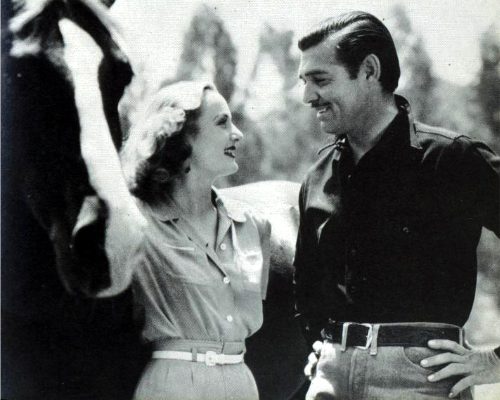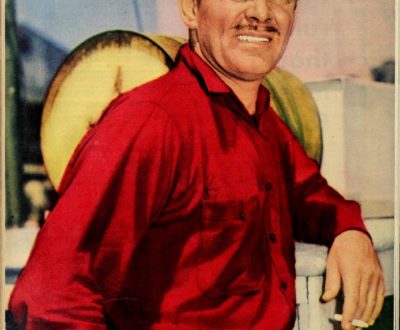{New Article} 1940: Two Happy People Part 3
In May 1940, the weekly magazine Movie and Radio Guide featured a new Clark and Carole article every week. I’m posting part 3 of 4, only because the articles came from a scrapbook and Part 3 seems to be the only complete one. While I try to put the pieces of the other parts together, here is Part 3, which is all about life on the ranch.
I was rather surprised to learn that the Gables had no swimming pool. A private swimming pool is as much a part of Hollywood existence as ballyhoo, bread and bourgeois. In the South, to judge your social status, they might ask you who your grandfather was. In the East, they might check you in Dun and Bradstreet. But in Hollywood, they’ll ask about your swimming pool. And if you expect to be a big frog, you’ve got to have a big pool.
And here two of the biggest names in the movie industry didn’t even have a footbath! It didn’t make sense. Mr. Gable explained it. He was sitting over there in the corner of his living room; sort of half sprawled in a big chair. On a maple table near him were two good books, Phil Stong’s “Horses and Americans” and “How Green Was My Valley.” Mr. Gable was wearing his house-slippers. The big mule, mutt and musket man has tender feet. That doesn’t mean he’s a tenderfoot, but the bottoms of his feet are very sensitive and tight shoes are agony to him, I like that. There’s something homey about a man whose dogs hurt him. After all, the Kid from Cadiz is a country boy. And when he gets home it is his prerogative to take off his shoes and wiggle his toes in his slippers.
“Tell you about that swimming pool business,” he said. “Mrs. G. and I are going to put one in this summer, maybe. I’ll show you where in a few minutes. If a couple moves into a place where everything is made to order, then they might soon get bored with it. Nothing to look forward to, you know. To enjoy a home a fellow has got to keep adding to it. So we are going to build our own pool; that is, supervise the building of it. And next year we’re going to put in a tennis court.”
Clark had tender feet? First I have heard of that! They never did put in that swimming pool. I am guessing that the war delayed their plans and then Carole died, he went to war and the idea faded. Clark did put a pool in at the ranch in the late 1940’s. He apparently never swam in it though. Guests, the neighbor’s children and later, Kay’s two children were the only swimmers in the pool. In fact, Clark proposed to Kay next to the pool in 1955. He never did put in a tennis court, however–although the estate currently has one.
The Gable farm—some call it a ranch, but it seems sort of silly to call a twenty-acre farm a ranch—is near Highway No. 101. There’s a wall around the place, and when you drive up to the big gate you have to get out of your car and press a button then whoop into a telephone. If you are admitted, a buzzer buzzes on the gate. It swings open. And lo! You are within the bounds of the House of Two Gables. The lane wanders up to the side of the house. There are beds of sweet peas and white pansies. Mrs. Gable often gets down on her glamorous knees and works her flowers.
A Buick station wagon is parked near a live oak, hard by the side of the house. Mr. Gable’s pet gun and his hunting clothes are in the station wagon. A dog runs out and barks at you. A black cat races across the lawn. You get out and stretch and drink the heady air, which smells of oranges, sweet peas, black earth and good wood.
The size of the house surprises you. It is not a mansion. The house itself looks like a cross between New England and Tennessee. In New England they would call it a cottage, and in Tennessee they would call it just a house. It is made of stones and clapboard, primly white with gay yellow awnings.
Mrs. G. selected the awnings and somehow they remind one of Carole Lombard—fresh, gay and flapping. Mrs. G. is a humdinger at decorating a house. She’s one of those rare persons who can take two bits’ worth of chintz and a pair of scissors and make something that looks pretty.
Doesn’t that sound so idyllic and peaceful? It’s no wonder Clark never did leave the ranch–oh, the author says I am silly for calling it that–the farm, then!–it was the one constant in his life, and I do believe that in staying there it was a piece of Carole he could hang on to.
The chicken yard belongs to Mrs. Gable. She has a flock of one hundred New Hampshire Reds, and chicken-runs are all nicely wired and partitioned. Mrs. Gable knows her chickens. She keeps them separated and gets a maximum production of eggs. Early every morning while the crown prince and jester are sleeping, a light goes on in the henhouse and the Reds go to work. She often gathers the eggs herself, sells them for top prices and keeps her own records. Just for the information of those who love chickens, she uses a laying-mash and a scratch feed. Each flock has a little fountain of bubbling water. The farmer’s wife believes that good water is the secret of healthy chickens.
She will talk your ears off about chickens and she knows her stuff. In fact, she’d rather talk about chickens than movies. She also has ducks and geese and pheasants.
“I like game birds to eat,” she said. “Even game chickens are good to eat.”
She is quite proud of her selection of a gift for Margaret Mitchell, who did “Gone with the Wind”—unquestionably her husband’s greatest picture. She knew Miss Mitchell (Mrs. John Marsh) is not the kind of person to whom you send an ordinary gift. So when she and her husband returned from Atlanta, where they met Mr. and Mrs. Marsh, Mrs. Gable sent four fat chickens to Mrs. Marsh. Of course, sending chickens from California to Georgia is something like sending coal to Newcastle. But anyway, it was an original idea. Mrs. Gable is full of them.
I’ve never heard that story about Margaret Mitchell; I wonder if that’s true. Seems an odd gift considering Margaret lived in downtown Atlanta! I love hearing stories about Carole’s pride in her home and her chickens and her overall rustic life. They both just seemed so content and so much like any couple you’d find on a farm in any state.
You can read the article in its entirety in The Article Archive



